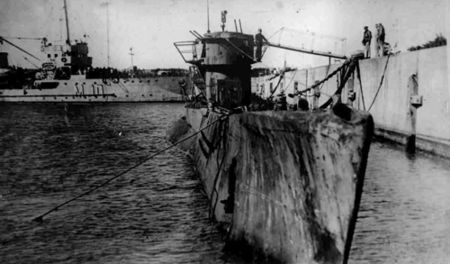U-977 moored at Mar del Plata naval base
Soon to become somewhat famous (or infamous) and the cause of wild speculation in the tabloids, the U-977, commanded by a new skipper, Heinz Schäffer, age twenty-four, sailed from Kristiansand on May 2 to patrol in the English Channel. Commissioned on March 31, 1943, in Kiel by Hans Leilich, age twenty-five, she had not previously made a war patrol. During workup in the Baltic, according to Allied intelligence documents, U-977 rammed (or was rammed by) other vessels three times. In the last incident, she incurred so much damage to the pressure hull that German authorities relegated her to school boat status.
In early 1945, Heinz Schäffer, crew of 1939, assumed command of the boat in Hamburg, where on February 20 she entered the yards to be fitted with a snort. Schäffer had made four war patrols, including one in the Gulf of Guinea, as a watch officer on the U-445, based in France. From December 1943 to December 1944, he had commanded the Type IID school duck U-148.
Schäffer said later that he regarded his new command as a “means of escape” from the Allies, rather than a combat vehicle. When Germany surrendered, the U-977 was outbound in Norwegian waters. Schäffer thereupon decided to cruise to Argentina and surrender to what he believed might be more hospitable authorities. “One of my main reasons in deciding to proceed to the Argentine,” he later said in an official statement to the Allies, “was based on German propaganda, which claimed that the American and British newspapers advocated … that all German men be enslaved and sterilized …. It was absolutely my intention to deliver the boat undamaged into Allied hands, while doing the best I could for my crew. I felt the ship’s engines might be a valuable adjunct to the reconstruction of Europe.”
Having reached the decision to flee, Schäffer said, he then gave the married crewmen a choice of going ashore or going to Argentina. About a third of the crew-sixteen men-voted to go ashore. On May 10 Schäffer ran in close to the Norwegian coast at the island of Holsenoy, unintentionally grounded the boat on some rocks, and put over the sixteen men in dinghies. He then sallied the boat off the rocks and set off for Argentina, about seven thousand miles away. All three of his officers, Watch officers Karl Reiser and Albert Kahn, engineer Dietrich Wiese and twenty-eight enlisted men remained on board. The sixteen men who left the boat were subsequently taken into custody by the British.
The voyage to Argentina was hideous. Schäffer remained completely submerged for a record sixty-six days-from May 10 to July 14-snorting for about four hours a day. The boat crawled southward into ever greater summer heat and many men, Schäffer remembered, were on the edge of nervous breakdowns. He stopped for four hours in the Cape Verdes for a swim call and then proceeded on the surface using one diesel to St. Paul’s Rocks, making good about 150 miles a day. When the boat crossed the equator (July 23) Schäffer authorized the customary initiation ceremony. Finally, on August 17, after a patrol of 108 days and 7,644 nautical miles, Schäffer put into Mar del Plata.
Latin American newspapers soon published stories stating that U-977 had secretly brought Adolf Hitler to Latin America to live out his life incognito. That false story spread to the tabloids worldwide, provoking a good deal of speculation as to whether or not it could be true.
It is improbable that Hitler-or any other high Nazi official-chose to escape on U -977. Given the high rate of loss of U-boats in the spring of 1945 (50 percent plus), the chances of survival on a fleeing submarine were extremely dim. Even if Hitler or some other high Nazi had chosen this risky means of escape, in all likelihood he would have demanded a bigger Type IX snort boat or an IXD2 U-cruiser snort boat, rather than a cramped VIIC. Moreover, young Heinz Schäffer was an unlikely choice of skipper for such an exalted mission. He had never made a war patrol in command of a V-boat and had not served in the Atlantic since October 1943. Furthermore, neither Schäffer nor his crew had any snort experience; U-977 had only recently been fitted with one.
Even if Hitler, notoriously prone to seasickness, chose to flee in a Type VII and to endure the hideous voyage that entailed, he would not have picked this particular VII, which had been thrice rammed in the Baltic and, because of pressure-hull damage, reduced to school-boat status. Moreover, while the U-977 was in the Hamburg shipyard to be fitted with a snort, Schäffer wrote later, the batteries “were only running at 70 percent efficiency.” He had requested new batteries, but “for want of material” his requests “had been rejected.” None of the thirty-two men on U-977 has come forward to confirm that Hitler (or his ashes), Martin Bormann, or other high-ranking Nazis traveled to Argentina in U-977. In the journalistic climate of the 1990s, an authentic story of that type would be worth millions.
After undergoing close interrogation by the Americans and British, in 1950 Schäffer returned to live in Argentina.
In a book, U-boat 977 (1952). In part, Schäffer said, he published his book to refute the many newspaper stories and a book published in Argentina (Hitler Is Alive) alleging that U-977 had brought Hitler to Argentina. The rumors continued. In the fictional Adolf Hitler and the Secrets of tile Holy Lance (1988), Buechner and Bernhart state that U-977 carried a “funeral urn” containing the ashes of Hitler and Eva Braun and other Nazi treasures to a prearranged site in an ice cave in Antarctica, which one of Dönitz’s U-boat crews had built in 1943.
